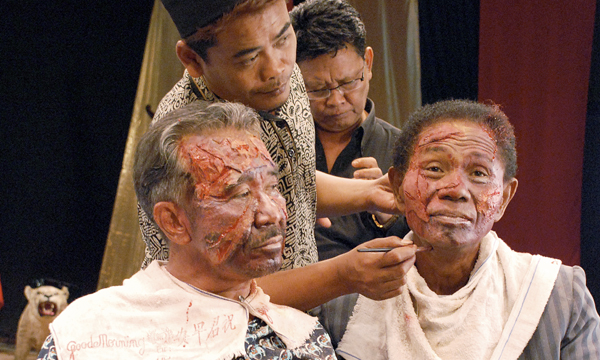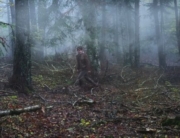![]() You may or may not remember a little movie from 1980 called Cannibal Holocaust about the discovery of film shot by a documentary team in the South American jungle. It captures the torturing of animals and rampaging and destroying of villages—until the native people fight back and kill the Western movie crew. It’s a gory exploitation film on the surface, but underneath it carries the horrific power and force of what terrors lie in the hearts of humankind through a movie lens. (And arguably it’s the first “found footage” film). Somehow the footage shot by its crew, which had the white conquerors taking over the indigenous population with force and violence (including real animal cruelty) made it all the more upsetting, and in a way more real.
You may or may not remember a little movie from 1980 called Cannibal Holocaust about the discovery of film shot by a documentary team in the South American jungle. It captures the torturing of animals and rampaging and destroying of villages—until the native people fight back and kill the Western movie crew. It’s a gory exploitation film on the surface, but underneath it carries the horrific power and force of what terrors lie in the hearts of humankind through a movie lens. (And arguably it’s the first “found footage” film). Somehow the footage shot by its crew, which had the white conquerors taking over the indigenous population with force and violence (including real animal cruelty) made it all the more upsetting, and in a way more real.
But why mention a notorious Italian horror fest in the same review as this documentary? Frankly, it was the closest thing I could think of to have caused such a visceral reaction. Only here, it’s much more astonishing and all real, harkening back to a time of bloodshed and oppression. In short, in The Act of Killing, we experience the tales of an Indonesian death squad leader, Anwar Congo, and others who were given the task, after the 1965 military coup that overthrew President Sukarno, to find, interrogate, and exterminate all Communists that they could find. Ultimately, millions died, and Congo killed hundreds, possibly a thousand, and none of the killers ever saw punishment for their crimes. On the contrary, they became something like celebrities. (The paramilitary is still a major presence in the country, with millions involved and the support of the government. The country’s vice president gives a speech in the film supporting their efforts.)
The filmmakers state up front that they know it will be difficult to get inside the minds of Congo and his cohorts through simple interviews, albeit director Joshua Oppenheimer still conducts them anyway, mostly in an easy going setting. They give these “movie gangsters,” so-called because they strangely love not only Hollywood movies but American culture, a most unusual opportunity: to reenact what went on in the genocide. Alright, you killers, go make a movie!
Congo and his friends reenact scenes of interrogations, torture, murder, and a burning and massacre of a small village with the use of sets and non-professional extras, including, God help them, kids. The latter’s involvement is especially disturbing, in part because Oppenheimer, for what seems to be the first and only time in the film, adds a music accompaniment (and very eerie tones at that) to images of this staged bloodbath and to its aftermath. The director of the massacre (one of the Indonesian crew) is satisfied with the scene, but thinks he has almost gone too far, which Congo agrees. They did such a good job re-creating such a horrific event—and they aren’t Coppola or Oliver Stone, they’re basically amateurs—that it’s another example of the filmed reality taking over and amplifying what actually happened. That the kids who were involved in this scene can’t be calmed down once shooting has stopped is all the more unnerving.
The philosopher Slavoj Zizek once said that often times the sense of reality in the fantasy, in terms of cinema, can be more real and potent than the reality itself. The Act of Killing is about this: how these seemingly monster-ish Indonesians face this concept when they are “playing” these scenes. But it’s also about Anwar Congo, who on the surface is a pretty cool looking guy. (Hell, he gets so into the act as one of the actors that he dyes his hair black.) In one of his particularly memorable TV appearances, the audience is made up of rabidly anti-communist paramilitary officers, and the interviewer cheers on all the death and destruction that’s described. Only when Oppenheimer cuts to the crew in the control booth, who comment on how many people Congo killed and what it must have done to him, do we get a sense of others off camera.
But amid all this, Congo, it appears, is haunted by his many crimes—he talks of nightmares based on his killings—but not all of the movie gangsters may feel the same. Adi Zulkadry, a comfortable family man with an oddly large collection of collectible jewelry, says it was all part of orders, taking out all the rotten people who deserved it, and that the winners never get punished for their crimes, so why feel guilty. Yet for Congo, acting in these segments builds up more and more of these ill feelings. He’s not an idiot (maybe crazy, though also dulled with age perhaps). He knows what went down and why.
In one of the most curious and gut-wrenching portions of the reenactments, Congo acts as one of the tortured and slain, and at some point he has to stop acting. He comments after a drink of water, “Now I know how they felt like,” but he’s reminded by someone, possibly the director, that the victims didn’t get to go home or stop the scene. So why he is acting here? For catharsis? Because he’s, frankly and ironically enough, one of the better actors on hand?
This masterpiece of reflected horrors accomplishes more than a movie like Cannibal Holocaust. The Act of Killing gives us painfully real-life people who go about their lives in peace and within a society that still embraces that period. The questions of bigger stature, like if these death squads will ever face punishment, are left for another day. What Oppenheimer leaves us is Congo’s legacy of destruction and death. His final scene, where he returns to the actual room where he killed his victims, is more shocking for his ambiguous reaction (actual disgust, nausea?) than any horror movie.

















It’s a shame you don’t have a donate button! I’d certainly donate to this outstanding blog!
I suppose for now i’ll settle for book-marking and adding your RSS feed to my Google account.
I look forward to new updates and will share this site with my
Facebook group. Chat soon!